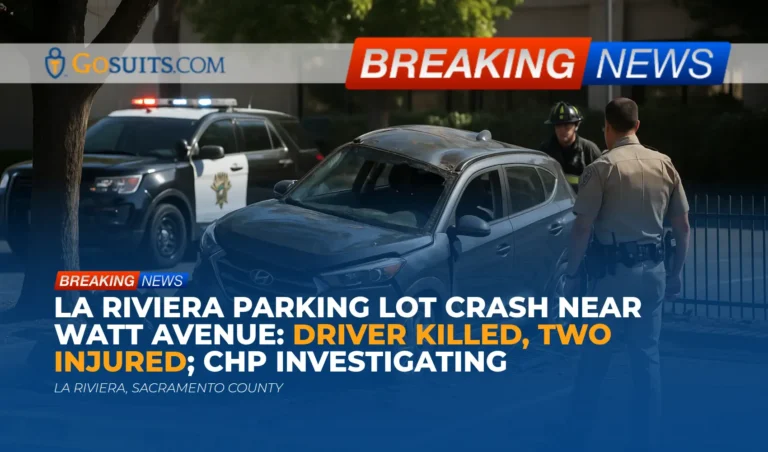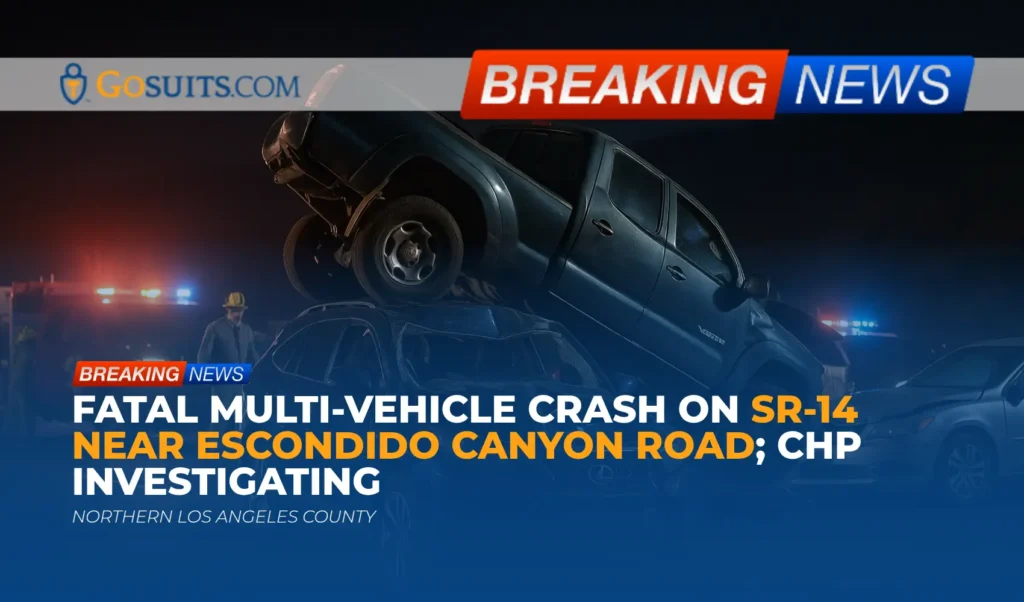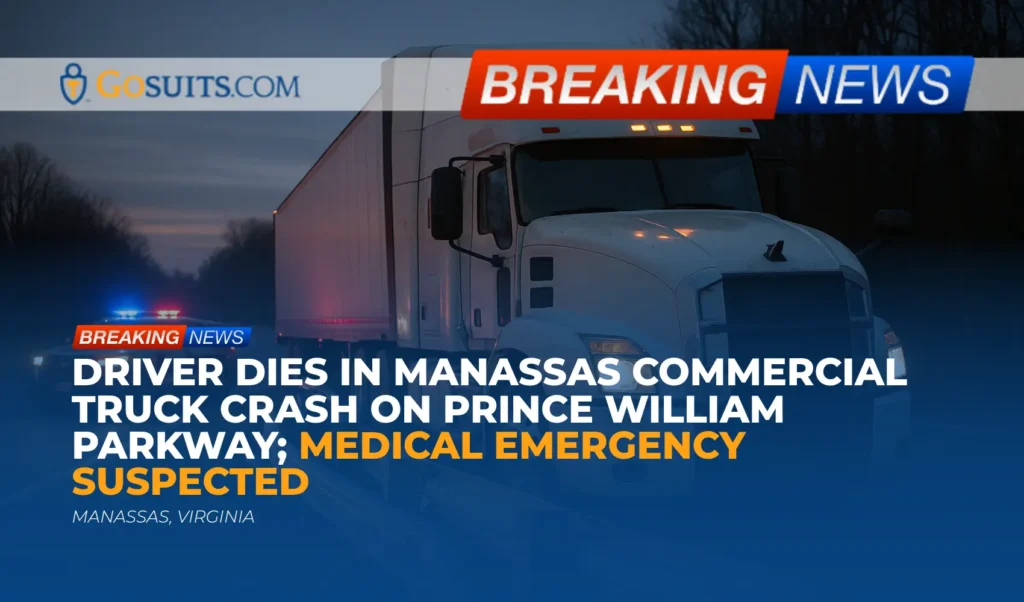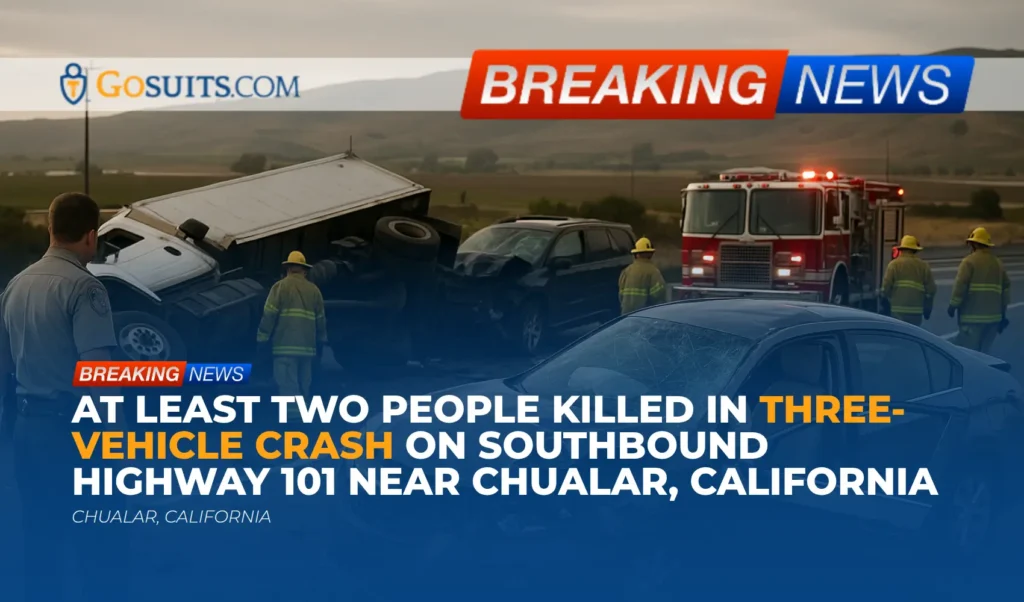- What We Know So Far About the La Riviera Parking Lot Crash
- Location and Agencies Involved
- Immediate Next Steps for Families and Witnesses
- How to Obtain Official Reports and Records
- Legal Rights and Potential Civil Claims
- Insurance Considerations After a Serious Crash
- Evidence Preservation and Independent Investigation
- Safety and Prevention Context
- How Community Members Can Help Responsibly
- Commentary from Gosuits La Riviera, California Personal Injury Attorney
- Practical Call-to-Action: Steps to Take Now
What We Know So Far About the La Riviera Parking Lot Crash
On Thursday afternoon, a serious single-vehicle collision occurred near the intersection of La Riviera Drive and Watt Avenue in La Riviera, Sacramento County. According to information publicly shared by responding agencies, a Hyundai Tucson traveling east on La Riviera Drive left the roadway at a high speed, struck a tree, overturned into a nearby parking lot, and collided with a metal fence. The crash caused extensive damage to the vehicle’s front end and to property in the lot.
The California Highway Patrol (CHP) responded at approximately 2:08 p.m. Sacramento Metropolitan Fire Department personnel extricated some occupants from the vehicle. The driver, an adult man, was pronounced deceased at the scene. Two passengers, a man and a woman, sustained major injuries and were transported to a local hospital. Officials have not publicly identified the deceased at the time of this writing. Investigators indicated they are evaluating whether alcohol, drugs, or a medical emergency may have contributed, but no determinations have been announced.
We share this information with deep respect for those affected. The following sections explain how families and injured passengers can find reliable public information, understand general rights in California injury and wrongful death matters, and preserve important evidence. This article is educational in nature and does not replace a consultation tailored to individual circumstances.
Location and Agencies Involved
The incident took place in La Riviera, an area within Sacramento County, near La Riviera Drive and Watt Avenue. Several agencies typically have roles in a crash of this nature:
- California Highway Patrol (CHP): Responds to and investigates many traffic collisions in unincorporated areas and on state routes. CHP collision reports, diagrams, and supplemental statements are central records for civil claims.
- Sacramento Metropolitan Fire District: Provides emergency medical response, rescue, and fire services. Fire incident and patient care reports can help clarify extrication needs, timing, and on-scene medical findings.
- Sacramento County Coroner’s Office: Handles identification of the deceased, cause and manner of death determinations, and communication with next-of-kin. Certain records may be available to immediate family or authorized representatives.
- Property Owner or Manager of the Damaged Parking Lot: May document property damage, preserve surveillance video, and communicate with insurers.
Immediate Next Steps for Families and Witnesses
In the early aftermath of a fatal or major-injury crash, it can be overwhelming to know what to do. The steps below focus on safety, information, and preservation of records:
- Ensure medical care and safety first: Injured passengers should prioritize medical evaluation and follow-up. New or delayed symptoms should be assessed promptly.
- Document what you saw and experienced: As soon as it is safe, write down details, take photographs of visible injuries, and keep records of medical visits. Witnesses who observed the vehicle’s movement, speed, or the sequence of impacts should make notes while memories are fresh.
- Preserve potential evidence: Save clothing and personal items from the day of the crash. If you are a nearby property owner or business, preserve any security camera footage covering La Riviera Drive, Watt Avenue, or the impacted parking lot during the relevant timeframe.
- Obtain official records: Collision reports, coroner information, and fire incident records often contain key facts. Details on how to request these are included below, with links to government sources.
- Be cautious with insurance communications: Before speaking with any insurance company, consider getting a free consultation with a qualified attorney. Statements given to insurers can be recorded and may be used to limit or dispute claims later.
How to Obtain Official Reports and Records
CHP Collision Report and Area Office
The CHP collision report typically includes the investigating officer’s narrative, diagram, and any citations or contributing factors identified during the preliminary investigation. To request a report:
- Use CHP’s official process: See “How to Obtain a Traffic Collision Report” and the CHP 190 request form at chp.ca.gov.
- Find the correct CHP office: Locate the appropriate Area Office (likely North Sacramento for La Riviera) using CHP’s office finder at chp.ca.gov/find-an-office.
If a specialized CHP Multidisciplinary Accident Investigation Team (MAIT) becomes involved in severe or complex collisions, additional technical documentation may exist. Inquiries about MAIT involvement can be directed through the Area Office listed above.
Sacramento Metropolitan Fire District Records
Fire incident and emergency medical response records can corroborate timelines, extrication, and initial condition assessments. For public records requests or fire incident reports, visit the Sacramento Metropolitan Fire District’s records page at metrofire.ca.gov/records.
Sacramento County Coroner and Autopsy Information
Next-of-kin may contact the Sacramento County Coroner for information about identification, cause and manner of death determinations, and potential availability of autopsy or investigative reports. See the Coroner’s Office site at coroner.saccounty.gov. Availability and eligibility for records may be limited by law to certain family members or authorized representatives.
Certified death certificates can be requested through the Sacramento County Clerk-Recorder. Instructions and eligibility are provided at clerkrecorder.saccounty.gov.
DMV Accident Reporting (SR-1)
California requires a report to the DMV when a traffic collision results in injury, death, or property damage above a statutory threshold. The SR-1 form must generally be filed within 10 days, regardless of fault, by involved drivers or their representatives. See the DMV’s accident reporting guidance and access the SR-1 form at dmv.ca.gov.
Medical Records Access
Injured individuals usually have rights under federal rules to access their medical records, including treatment and billing records. Guidance from the U.S. Department of Health and Human Services on the right of access is available at hhs.gov. For a deceased person’s records, a personal representative (such as an executor) may have rights to obtain records under applicable federal and state laws.

Legal Rights and Potential Civil Claims
Every collision is unique, and fault determinations should be based on thorough fact-finding. That said, there are recurring civil law issues in single-vehicle crashes involving passengers, property damage, and a fatality:
- Claims by injured passengers: Injured passengers may pursue claims against the at-fault driver’s liability coverage. If the driver is deceased, claims are typically asserted against the driver’s estate and insurer. If evidence suggests another party contributed (for example, a roadway defect or improperly placed fixed object), additional claims may be considered against those entities.
- Property owner claims: The parking lot owner or manager may seek property-damage recovery from the responsible party and insurers for fence and surface damage.
- Wrongful death considerations: When a driver dies, the driver’s heirs generally do not bring a wrongful death claim against the driver. However, if a third party’s negligence contributed to the fatality—such as a dangerous condition of public property—surviving heirs may consider a wrongful death claim against that third party, subject to strict deadlines and proof requirements.
- Potential roadway design or maintenance issues: If evidence identifies a dangerous condition of public property (sight lines, signage, guardrails, hazards adjacent to the roadway), claims may be considered against the responsible agency, such as a county or the State of California, depending on jurisdiction. These claims have special notice requirements and short timelines.
- Intoxication or reckless speed: If DUI is ultimately established by the investigation, it can have significant civil consequences. California law allows punitive damages in certain cases of oppression, fraud, or malice; courts have recognized that extreme intoxication leading to injury can support punitive damages in appropriate circumstances. See California Civil Code section 3294 at leginfo.legislature.ca.gov. No determination about DUI has been announced in this crash as of now.
Comparative Fault in California
California follows comparative fault principles in civil injury cases, which means a finder of fact can assign percentages of responsibility among multiple parties. An injured person’s recovery may be reduced by their share of responsibility, if any. The Judicial Council’s Civil Jury Instructions (CACI) provide general guidance on negligence and comparative fault for juries. See the CACI resources maintained by the Judicial Council at courts.ca.gov.
Statutes of Limitations and Government Claim Deadlines
- Personal injury and wrongful death: In general, California provides a two-year period to file lawsuits for injury or wrongful death. See California Code of Civil Procedure section 335.1 at leginfo.legislature.ca.gov.
- Claims against public entities: If a governmental entity may be responsible, a Government Claim must typically be filed within six months of the incident for personal injury or wrongful death. See Government Code section 911.2 at leginfo.legislature.ca.gov. For claims involving state agencies (such as Caltrans), the Government Claims Program within the California Department of General Services provides filing information at dgs.ca.gov.
These time limits have important exceptions and nuances. Speaking with an attorney promptly helps ensure the correct deadlines are identified for a particular situation.
Insurance Considerations After a Serious Crash
Insurance issues after a single-vehicle collision can be complex, especially when severe injuries or a fatality are involved. In California, several types of coverage may come into play:
- Bodily injury liability coverage: Generally addresses injuries to passengers or third parties when the driver is found negligent. If the driver has passed away, claims are typically made against the insurer and the estate, subject to policy limits and defenses.
- Medical payments (Med-Pay): Some auto policies provide no-fault medical payments coverage to occupants, which can help with immediate medical bills, regardless of fault. Terms and limits vary by policy.
- Uninsured/Underinsured Motorist (UM/UIM): If another liable party is identified and lacks adequate insurance, injured passengers may look to their own UM/UIM coverage. This can also apply in certain scenarios involving unidentified or minimally insured contributors to the crash.
- Property damage coverage: The parking lot owner may seek repair costs through property liability policies or claims against the at-fault driver’s property damage liability coverage.
Before speaking with any insurer or providing recorded statements, it is wise to consult an attorney. What is said to an insurance adjuster can be used later to dispute liability or minimize compensation. A free consultation can help clarify rights and obligations, including whether to file a DMV SR-1, how to report a claim, and how to protect privacy and medical information during the process.
Evidence Preservation and Independent Investigation
A thorough civil investigation frequently runs parallel to official investigations. Key sources of evidence in an event like this may include:
- Event Data Recorder (EDR): Many late-model vehicles contain an EDR that may record pre-crash speed, braking, throttle, and seatbelt status. The National Highway Traffic Safety Administration provides information about EDRs at nhtsa.gov. Prompt action is crucial because vehicles may be moved, salvaged, or repaired, and data can be lost.
- Scene inspection and measurements: Skid marks, yaw marks, debris fields, and impact points can illuminate speed and trajectory. Early documentation preserves information that can quickly fade due to weather, traffic, or repairs to the lot and fence.
- Surveillance and dashcam footage: Businesses or residences near La Riviera Drive and Watt Avenue may have footage of the vehicle’s approach, loss of control, or the rollover into the parking lot. Requesting and preserving this promptly is essential.
- Witness statements: Independent witnesses can corroborate speed, lane position, and driving behavior before the car left the roadway. Memories can fade quickly; obtaining written or recorded statements early helps accuracy.
- Official agency records: CHP collision reports and any supplemental technical analyses, as well as Sacramento Metropolitan Fire incident and medical response records, form the backbone of many civil evaluations.
In the most severe crashes, CHP may deploy specialized investigative resources to reconstruct the event. While civil attorneys often retain independent accident reconstructionists, families and injured passengers can also track official findings through the CHP Area Office process linked above.
Safety and Prevention Context
Roadway departure crashes—where a vehicle leaves the travel lane and collides with a fixed object—are a major source of severe injuries and fatalities nationwide. Two factors are often central in these events:
- Speed: NHTSA reports that speeding reduces a driver’s ability to steer safely around curves or objects and extends the distance necessary to stop. It also increases the energy of a crash, intensifying injuries. See NHTSA’s speeding safety overview at nhtsa.gov.
- Roadway departure risks: The Federal Highway Administration notes that roadway departure crashes account for a significant portion of serious crashes. Countermeasures include clear zones, forgiving roadsides, enhanced delineation, and barriers. More information is available through the FHWA’s Roadway Departure Safety resources at highways.dot.gov.
While these general safety principles help explain why single-vehicle collisions can be catastrophic, only a careful investigation of the local scene, vehicle condition, and driver factors can reveal exactly what happened in this La Riviera incident. It remains important to avoid speculation until authorities complete their work and evidence is fully reviewed.
How Community Members Can Help Responsibly
- Share information with investigators: If you witnessed the crash or have relevant video, contact the CHP Area Office handling the investigation. The CHP office locator is at chp.ca.gov/find-an-office. Provide your contact details, the time and location of the footage, and be prepared to preserve the original file.
- Respect privacy: Avoid sharing graphic photos or speculation on social media. Families often learn new details at difficult moments; consider their privacy and grief.
- Support local businesses affected by property damage: The parking lot owner or tenants may be dealing with repairs and temporary disruptions. Patience with detours or closures helps the community recover.

Commentary from Gosuits La Riviera, California Personal Injury Attorney
Our hearts go out to everyone affected by this devastating crash near La Riviera Drive and Watt Avenue. A life has been lost, and two passengers are facing major injuries. This commentary is meant for general information and education; every case turns on its own facts.
From a civil-injury perspective, early facts point to a high-speed single-vehicle roadway departure that led to a tree strike and rollover into a parking lot. For the injured passengers, the central questions typically include why the vehicle left the roadway, whether speed or an impairment or medical emergency played a role, whether seat belts were in use, whether the roadway environment contributed, and whether any mechanical issues or tire problems existed. For the deceased driver’s family, evaluating whether any third party played a role—such as a dangerous adjacent condition or deficient roadside features—can be important to understand the full picture.
Insurance companies and large corporations tend to move quickly after severe incidents. Adjusters often seek early statements, medical authorizations, and signed forms before injured people fully understand their rights. This is not necessarily because they have more accurate information; it is often because early statements can be used to minimize responsibility or cast doubt on the seriousness of injuries. Carefully choosing when and how to communicate with insurers can prevent misunderstandings and protect a fair assessment of the claim.
A free consultation with a seasoned and skilled attorney helps people understand deadlines, the role of comparative fault, the availability of coverage like Med-Pay or UM/UIM, and the need to preserve critical evidence such as EDR data and surveillance video. It also ensures that if a public entity may be involved, the six-month Government Claim deadline is not missed, and that the DMV’s SR-1 reporting requirement is properly handled. Speaking with counsel before contacting insurers can prevent inadvertent statements that later complicate recovery.
Practical Call-to-Action: Steps to Take Now
- Collect and safeguard documents: Gather medical discharge papers, bills, photographs of injuries and property damage, and any correspondence from insurers. Keeping a centralized file makes it easier to meet deadlines and provide accurate information when needed.
- Request official records promptly: Start requests for the CHP collision report, fire incident records, and, where applicable, coroner documents. Some records take time to process, and early requests help avoid delays in understanding the facts.
- Preserve digital evidence immediately: Save any dashcam or security footage. Ask nearby businesses or residents to retain relevant video. Many systems automatically overwrite footage in days or weeks, so time is of the essence.
- Avoid early recorded statements: Refrain from giving recorded statements to any insurer until after a consultation. Early statements can be taken out of context and may affect later evaluations of fault and injury severity.
- Calendar critical deadlines: In California, many personal injury and wrongful death claims have a two-year statute of limitations, and claims involving public entities may require a Government Claim within six months. The DMV generally requires the SR-1 within 10 days for crashes involving injury or death. Acting now prevents missed windows that can bar claims.
- Seek a free legal consultation: A no-cost case review provides clarity on coverage options, potential defendants, evidence needs, and the safest way to approach insurers. Understanding these points early often shapes a more complete and accurate investigation.
- Prioritize health: Continue follow-up medical care and attend scheduled appointments. Consistent medical documentation supports both recovery and an accurate account of injuries.
Why acting now matters: physical evidence can disappear, vehicles may be salvaged, electronic data may be lost, and memories fade. Early steps help ensure that the story of what happened is preserved, that legal time limits are met, and that families and injured passengers have the information they need to make informed decisions moving forward.






